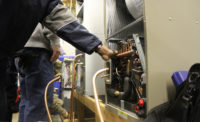How technicians troubleshoot refrigeration system problems is very personal. Each technician has his or her own style and will use various methods. Some of these methods were learned in school, others were learned from other technicians, and some were developed on their own.
I learned one method many years ago from my father. I can remember my dad arriving at a job site, touching a few pipes and parts, then telling me the problem with the system. He was most likely guessing at the time, but I didn’t know that — I thought he was just that good.
Although you can never rely on this “touch test” method alone to find the root cause of a system problem, it can be a valuable first glance into discovering the issue. Just keep in mind, you will always need your test instruments to find and verify the actual system problem.
On a properly operating system, there are many temperatures and temperature relationships you can feel by touch.
Depending on the system design and application, touching certain areas of the system may allow you to get a sense of how it is functioning. Where you sense these temperatures and temperature relationships will vary by design and application, so, to use this method effectively, you must first understand the design of the system you are examining.
Also, as with everything we do, remember safety comes first. Be careful where you touch; there are some parts of an operating (or poorly operating) system that could be extremely hot and could burn your hand. So, again — be careful.
One useful area to touch is the body of the compressor. On a reciprocating compressor, the top of the compressor should not be extremely hot. Therefore, extreme heat is likely a sign that it is overheated. You cannot determine exactly why it is overheated without further investigation, but at least it allows you to start to identify the system problem.
Do not touch the top of a scroll compressor as it is part of the discharge passage and will normally be quite hot. Knowing what and where to touch is a big part of using this initial procedure.
Touching the suction line leaving the cabinet can also be telling. On a properly operating system, the suction line should be cold or frosted, depending on the application. If it’s at or close to the ambient temperature, this can be a sign of a starved evaporator. Again, you cannot tell exactly why the evaporator may be starved without using your test instruments.
Another potential area to touch is the liquid line leaving the condenser or the system’s filter/drier. Depending on the system design and application, you may be able to “sense” how the high side of the system is operating. For example, on an indoor air-cooled condenser, I would expect the liquid line to be slightly above the ambient air temperature.
Using the touch test can provide a useful first glance at a system as long as you remember safety first and understand the various temperature relationships of a properly operating system.








